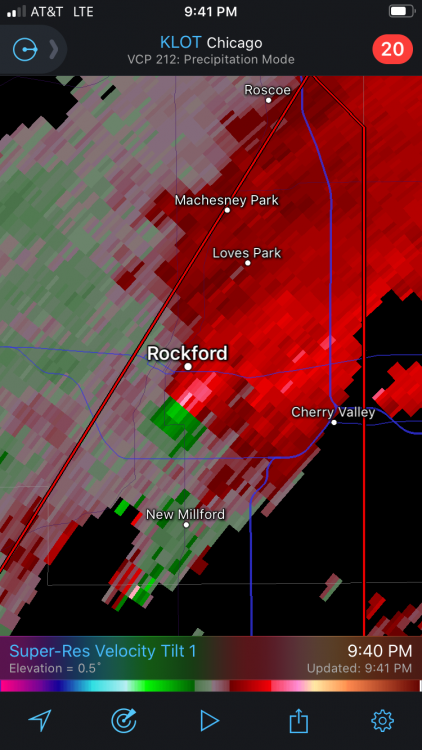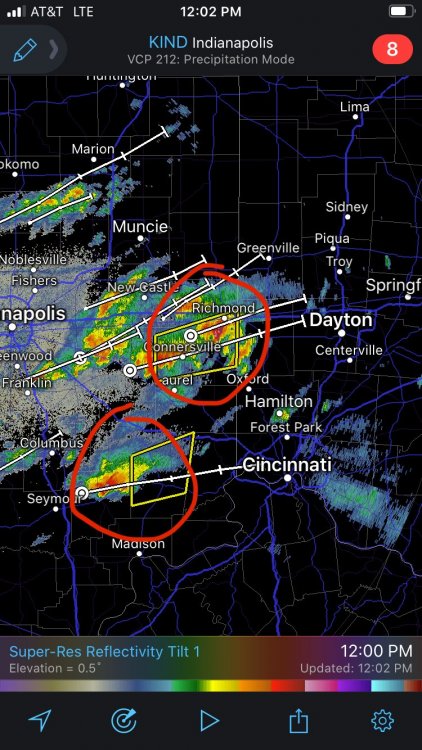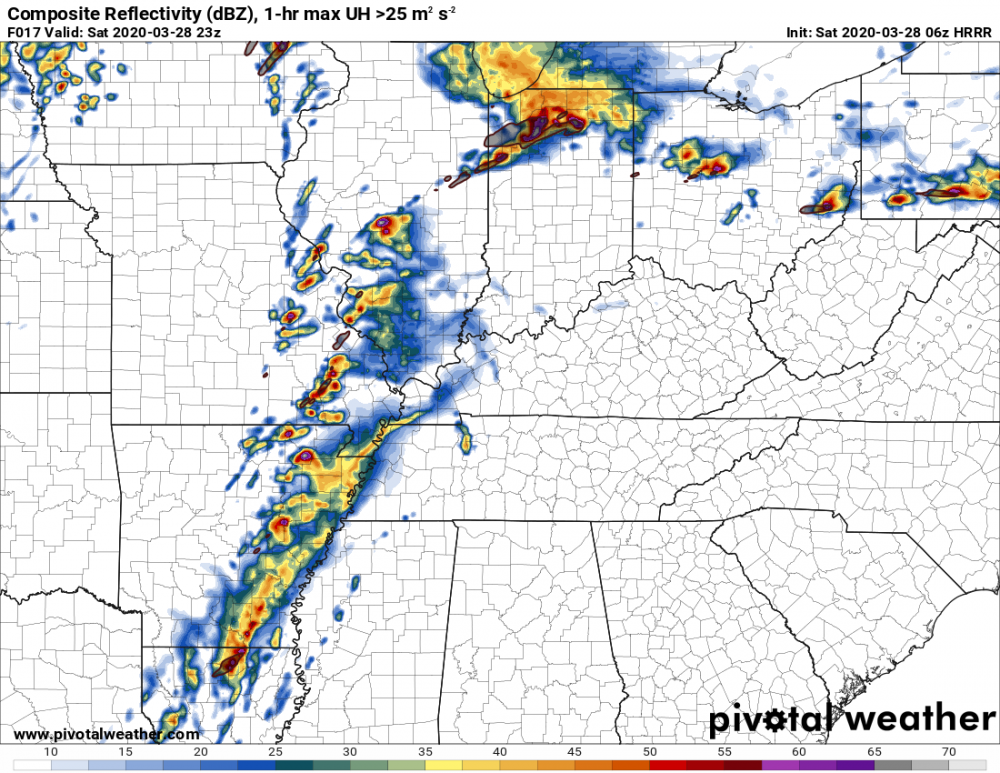-
Posts
515 -
Joined
-
Last visited
Content Type
Profiles
Blogs
Forums
American Weather
Media Demo
Store
Gallery
Posts posted by Sydney Claridge
-
-
Another point of note: observations of dew points in most of northern Ohio are in the mid-to-upper 20s right now (although dewpoints are about 50 down by Cincinnati). Today's 12z and 18z HRRR runs show northern Ohio to be a possible area for (potential?) surface-based convection tomorrow afternoon, and I am having trouble believing this scenario given how dry the surface airmass currently is. That said, SPC has said this would be an area of subsidence following the morning convection.
18z NAM3K puts 60s dewpoints in place across all of Illinois, Indiana, and most of Ohio (except the NE corner). Both 18z NAM3K and NAM runs would be more favorable for isolated tornadoes given lesser T/Td spreads relative to HRRR runs (although HRRR does show more convective activity, it also shows more mixing and thus larger T/Td spreads). -
With the COVID-19 pandemic and all, getting a major tornado outbreak (or just one major tornado striking a populated area) would be horrific, especially once you consider the need for hospital beds for both the injured and COVID-19 patients. It would be much more manageable if the tornadoes stuck to rural areas, but that is never a guarantee; just look at what happened back in 2011. Something like the 2011 Joplin tornado (which destroyed a hospital), if it occurred today, would be a lot worse given the current pandemic.
A quiet pattern is a much needed reprieve right now, and hopefully we don't have to worry too much about severe thunderstorms and tornadoes until COVID-19 quiets down somewhat. But you never know, especially considering that we are now in the most active time of year for severe thunderstorms and tornadoes (April/May/June).-
 1
1
-
-
21 hours ago, snowlover2 said:
ILN has a very detailed disco in the new afd. They say they wouldn’t be surprised to see an upgrade from the slight risk.
12z HRRR lends some credibility to ILN's discussion from yesterday, as it depicts the initiation of scattered cells in NW Ohio around 18z (with motions to the SE), and some of this activity could move across the northern part of ILN's area of responsibility (Dayton and Columbus areas mainly). If taken verbatim the risk would be higher in Columbus (storms in metro area) than Dayton, but you should never take a model run verbatim.
South of I-70 the 12z HRRR seems to depict greater mixing with larger T/Td spreads (upper 70s/lower 80s with mid-to-upper 50s dewpoints). Along and north of I-70 the T/Td spreads (lower 70s with lower-to-mid 60s dewpoints) suggest isolated tornadoes are a possibility with any supercells given lower LCLs and sufficient EHI.
As with respect to other models, 12z NAM3k and NAM still struggle to initiate storms, however. 12z HRW WRF-ARW shows cellular activity in NE OH (lower dewpoints however); 12z HRW NMMB has higher dewpoints and cellular activity in N/NE OH (and ramps things up a little in the MO/IL border region later on, though highest EHI values depicted are in OH); 12z HRW WRF-NSSL tries to send up cells in E OH but they struggle to get strong.
The new Day 2 SPC convective outlook seems to think that morning convection in Ohio will cause subsidence in its wake, which may cast doubt on cellular storms in the Ohio vicinity starting around 18z as depicted by the HRRR.The Slight risk now extends from the Ohio Valley to the Southeast (Carolinas) and Mid-Atlantic (VA) coast. There is also a broad 2% tornado risk shaded across this area (although it would not surprise me to see upgrades in a few areas, especially if that early-afternoon cellular storm mode in OH verifies, and maybe further west in IL/IN too, since some of the models show higher parameters over there too).
-
This isn't my subforum, but I was wondering some things about the severe potential for Tuesday 4/7. The NAM3k runs (12z and 06z) seem to be ramping up parameters for tornadoes in the eastern parts of the Day 3 Slight risk area (Ohio in particular), although they are not initiating convection. Plain NAM (12z run) may be trying to pop something in central Ohio with some good CAPE/helicity overlap; I'm taking this with a grain of salt though. I know tornadoes are less likely in northwest-flow regimes even with favorable parameters, but seeing relatively-high 0-3 km EHI values on model runs (GFS shows somewhat-elevated EHI slightly further west too) does catch my eye. I would post the imagery but my Internet connection has been painfully slow with the COVID-19 situation and all.
I also recall back on March 28th, models (NAM-based, RAP, and HRRR mainly) were showing elevated EHI near the OH/PA/WV border region, and some of that verified with severe thunderstorm reports (and a tornado warning) around Pittsburgh that day, well east of what was expected to be the "main" outbreak in IA/IL (which as we know largely busted). I was wondering if this might be a similar situation where much of the main action occurs further west, but with a few storms possibly going severe further east. -
Turns out today will be defined by a southward-surging cold front and then chilly temperatures. Temperatures around Oklahoma City and north-northwestwards are below freezing this morning (and there is even some elevated instability above that cold layer too). Except for southern Texas, forget any potential for severe, aside from perhaps elevated hail producers in some areas of central Texas. Later on, there may possibly be some cells initiating near the Serranias del Burro of northern Mexico and then moving into southern Texas.
Should be a quick chilly spell this weekend before warm and humid air begins to surge northwards on Sunday and (especially) Monday. Enjoy it if you like cold weather as this could easily be the last time we see temperatures like these until next fall. -
I am starting to wonder about this rainy pattern currently present across the north-central Texas region. With all this moisture in place, and with the region being within an active pattern for precipitation, sooner or later I would not be surprised to see a major severe weather event unfold (I'm not saying that will happen, though). At the moment cool temperatures are dominant, but next week looks as if conditions could get quite warm and humid, possibly setting the stage for severe weather.
Additionally, late this week, SPC discussion suggests the possibility of some severe weather in TX on Friday (4/3). Longer-range models (GFS and Euro) suggest that there could be a storm system early next week, with possibly another system around the middle of next week. While less pertinent to this region, the early-week system may also get pretty strong as it moves up towards the Great Lakes at mid-week (if GFS/Euro are correct, especially GFS, and that might mean severe storms in the IA/IL region that was largely spared from having a tornado outbreak last week). -
-
Very strong rotation evident as this storm moves towards Rockford. Hopefully the cool surface temperatures temper things a little bit, but I wouldn’t bet on it.
EDIT: rotation seems to have weakened in the last frame or so.
-
Another weaker area of rotation seems to be either over or just north of Washington, IL as well, associated with the tornado-warned storm that went through Peoria.
-
-
That convection over western MO seems to be modeled (according to the 11z HRRR and the RAP shown on the SPC Mesoanalysis site) to make it to the Quad Cities in about 4 hours or so. The setup is not looking as potent as it did yesterday, but there may be some time to destabilize after this line passes.
-
10z HRRR still has high EHI and STP values around the IA/IL/MO border region, and now brings those values further east into NW IL, although I am not sure if this is the start of a trend. We'll see what happens with the "crapvection" and precipitation shield in NE OK and SE KS as it moves northeast, but I do not want to rule out a localized tornado outbreak just yet, though that MDT risk should be trimmed back away from the Chicago metro area. The warm front from central Illinois into southwest Pennsylvania may also need to be watched closely as well, and I would not be surprised to see a higher risk category added along that boundary.
EDIT: I definitely spoke too soon earlier about that convection in OK weakening, although that severe-warned storm near Tulsa appears to be weakening as it does not look as well organized as it was earlier. EDIT 2: severe t-storm warning dropped, and now that line is developing down into central Texas. Looks like I may get some thunder soon. -
Some of those storms in OK may be trying to drop in intensity, especially north of OKC. I’m starting to see more yellows and a little less of reds and oranges on the radar (with radar returns around the stronger cores), although I am not sure if this is the start of a weakening trend. Perhaps some cloud/anvil debris is interfering with storms to the north of OKC?
-
6 minutes ago, janetjanet998 said:
The current OK stuff is the crapvection..the northern edge precip/clouds will be over IL by midday
Makes sense. I guess on the bright side a lot of worries about strong, long-tracked tornadoes could be alleviated, provided that this convection holds together. That said, it looks like the risk for severe thunderstorms might have increased along the I-70 corridor in Indiana, Ohio, and SW Pennsylvania. Cities like Indianapolis, Dayton, Columbus, and Pittsburgh could now be in the line of fire, and what's crazy is that 08z HRRR outputs PDS soundings at 18z near Pittsburgh. Several HRRR and RAP runs, for about the last day or so (though on-and-off to an extent as I recall), have shown an area of increased parameters in E OH and SW PA.
-
One of those storms in Oklahoma just went severe, and it is moving extremely fast to the northeast. Although this should go in the Central/Western States subforum, this is the main thread for this severe weather event, so I’ll go ahead and post this warning here.
QuoteBULLETIN - IMMEDIATE BROADCAST REQUESTED
Severe Thunderstorm Warning
National Weather Service Norman OK
342 AM CDT Sat Mar 28 2020The National Weather Service in Norman has issued a
* Severe Thunderstorm Warning for...
North central Comanche County in southwestern Oklahoma...
Northwestern Grady County in central Oklahoma...
Southern Caddo County in southwestern Oklahoma...
East central Kiowa County in southwestern Oklahoma...* Until 415 AM CDT.
* At 342 AM CDT, a severe thunderstorm was located 6 miles northwest
of Boone, moving northeast at 85 mph.HAZARD...Ping pong ball size hail and 60 mph wind gusts.
SOURCE...Radar indicated.
IMPACT...People and animals outdoors will be injured. Expect hail
damage to roofs, siding, windows, and vehicles. Expect
wind damage to roofs, siding, and trees.* Locations impacted include...
Anadarko, Carnegie, Apache, Fort Cobb, Verden, Amber, Gracemont,
Pocasset, Meers, Boone, Albert, Lake Chickasha, Fort Cobb
Reservoir, Stecker and northeastern Wichita Mountains Wildlife
Refuge.PRECAUTIONARY/PREPAREDNESS ACTIONS...
For your protection move to an interior room on the lowest floor of a
building.EDIT: the activity in central IL (from Springfield to Champaign) looks like it may be trying to fall apart. Unless more convection tries to form later on (as twistingtornado suggests if the 06z HRRR run verifies), the warm front may not have too much of a problem moving northwards towards the I-80 corridor. However, 08z HRRR is showing storms in northeastern MO at around 15z, and the HRRR model says that this would be the northeastern continuation of the activity currently approaching Oklahoma City.
-
17 minutes ago, twistingtornado said:
06z HRRR run has no discrete cells forming in Northern Illinois due to earlier crapvection. Compare 00z run to 06z run valid at 18z. The cap doesn't hold as a shortwave trough ejects northeast over Iowa in the late morning. Threat for northern Illinois would be nil. A messy storm mode ensues in west and central Illinois, but looks like there could be a few discrete cells that take advantage of their environment in that region. This is trending toward an enhanced risk instead of a high risk.
What is interesting right now, however, is that much of the “crapvection” is well north of the surface warm front, aside from what is present in central IL north of I-70, and an area of convection trying to form a line way back in western Oklahoma and northern Texas. The entire state of Missouri seems to be free of convection for the moment, so I am starting to wonder about the impact that TX/OK activity might have if it holds together.
-
-
13 minutes ago, Indystorm said:
HRRR just won't back off. Now develops tornadic cells ahead of the main line including one nw of LAF area.
If those HRRR runs verify I would not be surprised to see (potentially tornadic?) supercells as far east as Pittsburgh. This (05z) HRRR run puts a cell pretty close to Columbus, OH (at 20z) as well, not to mention RAP also shows precipitation along that warm frontal boundary in Indiana/Ohio/SW Pennsylvania.
-
1 minute ago, yoda said:
30% hatched hail is JUST south of Chicago metro
Almost all of the Chicago metro is in the 30% hatched hail risk. And a 10% hatched tornado risk all the way to the lake, with the 15% hatched tornado risk getting into the western parts of the metro.
-
SPC MD says the storms in central MO are elevated, but I am starting to wonder about that cell approaching Jefferson City. SPC Mesoanalysis shows 1000+ J/kg SBCAPE, 0-3km EHI between 2 and 3, and little CIN in that area.
This looks to be a major hail producer nevertheless. -
SPC Mesoanalysis is showing an area of upper-60s dewpoints just east of St. Louis right now. If these high dewpoints are already in place, I do not want to discount the possibility of dewpoints around 70 in Illinois tomorrow.
-
26 minutes ago, joshwx2003 said:
Holy cow STP values are maxed out with the 12z HRRR 33 hours out
I believe those maxed-out STP values are from convectively-contaminated model output, which is not reflective of the background environment. Nevertheless the 12z HRRR still shows high STP values in the background environment.
EDIT: never mind, given the linked post from Vortex Crew below. I was looking at the 12z HRRR output on Pivotal Weather. -
06z HRRR has a major storm complex moving through Illinois, Indiana, and Ohio (and even into SW PA/N WV) during the morning hours on Saturday (overnight/early morning in IL), before the main action would get started in Illinois. While generally elevated, some of this complex is modeled to get fairly close to some SBCAPE. If this complex verifies we might see outflow boundaries come into play later in the day, but my experience with HRRR models is that they are quite bullish.
-
1 minute ago, Hoosier said:
It is a pretty good setup, but 11/17/13 had a larger area of better tornado potential than this does. I am not sure I agree with the comparison even if we limit it to Illinois, but you can make a better case with that vs a larger regional comparison.
I agree with that. April 9, 2015 may be the better comparison here, especially with the similarities in expected areal coverage for significant tornadoes. 11/17/13 was generally further east with the favorable area for tornadoes extending across Indiana and even into Ohio (though few tornadoes occurred in OH, several touched down in northern IN).






Apr. 6-8 Severe Risks
in Lakes/Ohio Valley
Posted
Yikes, the 21z RAP is putting out high EHI values (and PDS TOR forecast soundings) near Chicago, and then over into northern IN and SW MI, with some precipitation in the area. Probably overdone, but maybe that risk area does need to be shifted NW a little bit, considering that several models are putting northern Illinois in an area of severe storm risk?